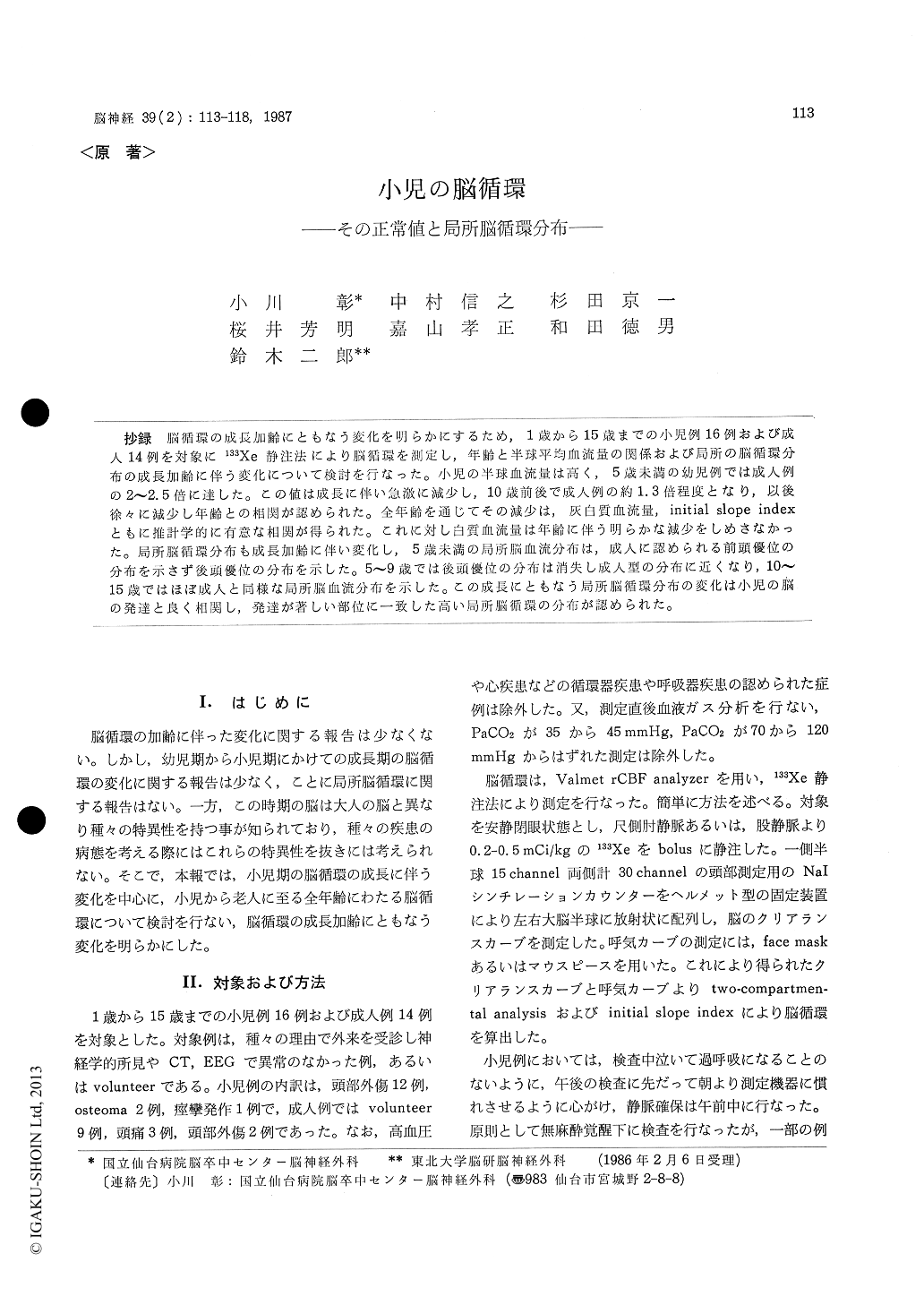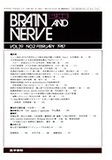Japanese
English
- 有料閲覧
- Abstract 文献概要
- 1ページ目 Look Inside
抄録 脳循環の成長加齢にともなう変化を明らかにするため,1歳から15歳までの小児例16例および成人14例を対象に133Xe静注法により脳循環を測定し,年齢と半球平均血流量の関係および局所の脳循環分布の成長加齢に伴う変化について検討を行なった。小児の半球血流量は高く,5歳未満の幼児例では成人例の2〜2.5倍に達した。この値は成長に伴い急激に減少し,10歳前後で成人例の約1.3倍程度となり,以後徐々に減少し年齢との相関が認められた。全年齢を通じてその減少は,灰白質血流量,initial slope indexともに推計学的に有意な相関が得られた。これに対し白質血流量は年齢に伴う明らかな減少をしめさなかった。局所脳循環分布も成長加齢に伴い変化し,5歳未満の局所脳血流分布は,成人に認あられる前頭優位の分布を示さず後頭優位の分布を示した。5〜9歳では後頭優位の分布は消失し成人型の分布に近くなり,10〜15歳ではほぼ成人と同様な局所脳血流分布を示した。この成長にともなう局所脳循環分布の変化は小児の脳の発達と良く相関し,発達が著しい部位に一致した高い局所脳循環の分布が認められた。
The changes in CBF and rCBF through the entire age range include the rapid period in childhood was reported.
Sixteen children between the ages of 1 and 15 add 14 adults were studyed. These 30 subjects were either volunteers of out-pationts without CT and EEG abnormalities. rCBF was measured by the 133Xe intravenous injection method using Var-met rCBF analyzer. Ther relationship between age and CBF, the correlation coefficient was cal-culated based on the regression equations and the regression curve with the highest correlation was chosen. For the analysis of rCBF, he mean rCBF values (ISI) of 3 channels corresponding to the frontal, temporal, parietal and occipital lobes were expressed as a percentage of the hemispheric CBF.
The hemispheric blood flow (ISI and CBF gray) of children less than 5 years of age was approxi-mately twice that found in adults. This value decreased rapidly with age and in the 10-15 years the blood flow was approximately 1.3-fold that of adults. Thereafter, there was a slow decrease and a negative correlation with age was found. The decrease showed the correlation on the fol-lowing equations ; y=146.5-58.5log x. (r=-0.903) for ISI and log y=2.26-0.29 log x. (r=- 0.881) for CBF gray, which was statistically sig-nificant. In contrast, the CBF white showed a slightly higher value in the 1-2 years old child-ren, but thereafter the CBF did not show a notable decreases with age. Through the entire age range, a best fit for the Fw values was found with : y= 18.3+37.5/x. (r=0.798), which was also statisti-cally significant.
The regional flow distribution in the children under 5 years of age were 96.2±2.1, 101.9±1.9, 101.1±1.6 and 104.6±3.1%, respectively, at thefrontal, parietal, temporal and occipital regions. That is, a relatively high value was found poste-riorly and a relatively low value anteriorly. In the children between 5 and 9 years of age, the distribution was, respectively, 102.1±2.1, 100.0 ±1.7, 99.6±3.2 and 98.8±3.2% showing a re-versal of the earlier pattern, such that now rela-tively greater blood flow was found anteriorly. In the children between 10 and 15 years of age, the rCBF pattern was 105.1±2.2, 101.8±2.6,97.7±1.5 and 99.9±2.8%, respectively. Here the highest value was at frontal cortex. The pattern in adults was similar to that of the 10-15 years old group (105.0±4.4, 101.9±4.7, 96.2±4.1 and 100.6±4.2, respectively). Significant differences were found between group 1 and group 2 and be-tween group 2 and group 3, but a difference be-tween group 3 and the adult group was not found.

Copyright © 1987, Igaku-Shoin Ltd. All rights reserved.


